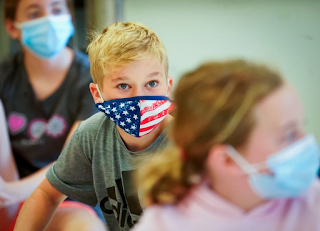
Photo by Mary Altaffer, The Associated Press
—–
The state Department for Public Health and the Department of Education are recommending that people who aren’t fully vaccinated against the coronavirus wear masks in schools when classes resume next month.
The health department issued the guidelines Thursday. It and the education department
said local school officials should “review the updated guidance documents and allow them to inform their decision making.”
Just what those officials will do is uncertain. Some parents have launched a campaign to let parents make their own decisions, reports Valarie Honeycutt Spears of the
Lexington Herald-Leader. When the
Jefferson County Public Schools said they would require masks for unvaccinated students, an armed man
was charged with threatening the superintendent.
The guidelines say school officials should consider the level of community transmission of the coronavirus, the level of vaccination against it, the ages of children in a school and “associated social and behavioral factors that may affect the risk of transmission and feasibility of different prevention strategies.” Children under 12 are not yet eligible for coronavirus vaccination.
Also, the guidelines say school officials should promote vaccination, offer it at schools, and consider a testing program to screen unvaccinated students, teachers and staff for the virus, to thwart its spread. People can catch and spread the virus without having any symptoms.
The guidelines recommend mask use indoors and say it “is particularly important when physical distancing is not possible or when other activities with elevated risk,” such as singing, shouting and blowing musical instruments.
On school buses and other public transportation, everyone 2 and older should wear a mask unless they qualify for an exemption, the guidelines say.
Universal masking
They also say use of masks by everyone should be considered in schools that have students who can’t be vaccinated, low vaccination rates, or “inability to monitor the vaccine status of students and/or teachers and staff.” It also said universal mask wearing should be considered if the community wants it, and in case of “increasing or high virus transmission in the community or school” or “difficulty monitoring or enforcing mask policies that are not universal.”
The health department also issued recommendations for physical distancing: at least three feet between students in classrooms where not everyone is fully vaccinated, and at least six feet “between students and teachers/staff, and between unvaccinated teachers/staff.”
Also, “To the greatest extent practicable, schools should reduce the number of students in each classroom, turn desks to face the same direction, utilize assigned seating, and remove nonessential furniture. Maximize physical distancing for unvaccinated persons who are eating meals indoors. When it is not possible to maintain a physical distance of at least three feet, it is especially important to layer multiple other prevention strategies, such as indoor masking.”
The guidelines recommend cohorts or “pods,” stable groups with fixed membership that keep together through activities, “especially when it is challenging to maintain physical distancing (e.g., young children) or when other layered prevention strategies are discontinued. . . . A modified strategy of only implementing universal mask use during activities when physical distancing is not feasible (e.g., changing classes, mixing of cohorts) may also be considered.”
On other points, the guidelines recommend improving ventilation and cleaning, teaching and reinforcing hand washing or sanitizing, and keeping out of school students, teachers and staff who become ill, test positive for the virus or, if they are not fully vaccinated, have close contact with anyone who has been diagnosed with the Covid-19 disease. “A close contact is someone who was within six feet of an infected person for a cumulative total of 15 minutes while the person was considered contagious,” the guidelines say.
